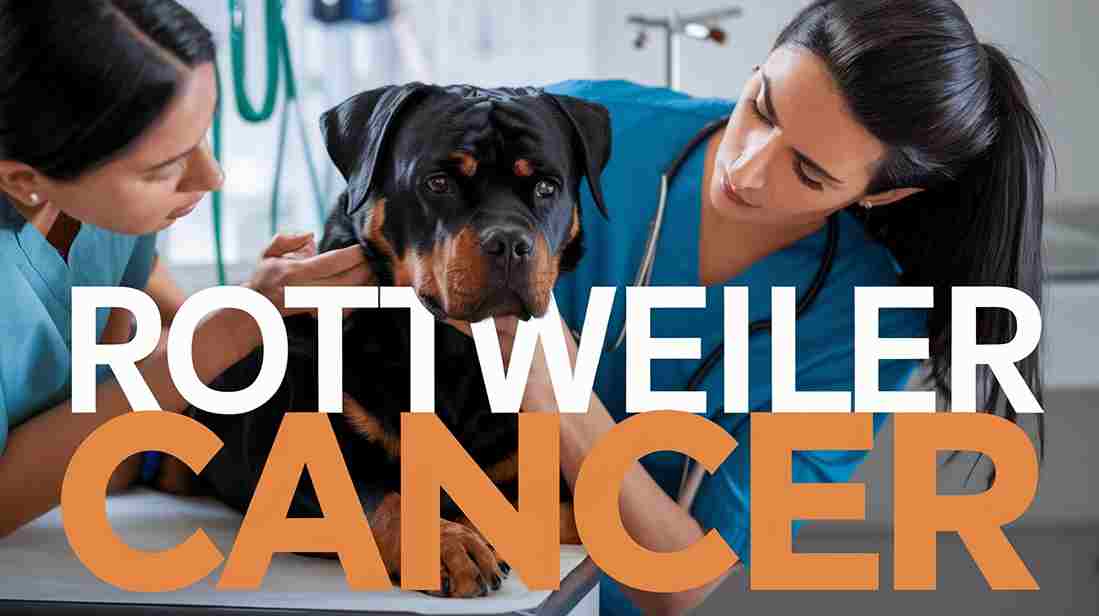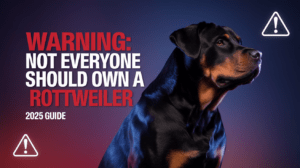-
Rottweilers are prone to cancer: Be aware of common types and their symptoms.
-
Early detection is key: Monitor for any changes in your dog's health.
-
Treatment options vary: Surgery, chemotherapy, radiation, and more.
-
Healthy lifestyle matters: Good diet, exercise, and vet care help.
-
Owner support is crucial: Be there for your Rottweiler throughout their journey.
When Sarah first noticed her beloved Rottweiler, Max, was less enthusiastic about their morning walks, she didn’t think much of it. But when he started showing signs of discomfort and lost interest in his favorite activities, she knew something wasn’t right. Like Sarah, many Rottweiler owners face the challenging reality that their loyal companions have a significantly higher risk of developing cancer compared to other breeds.
This comprehensive guide will walk you through everything you need to know about cancer in Rottweilers, from early warning signs to the latest treatment options, helping you protect your four-legged family member.
Understanding Cancer in Rottweilers
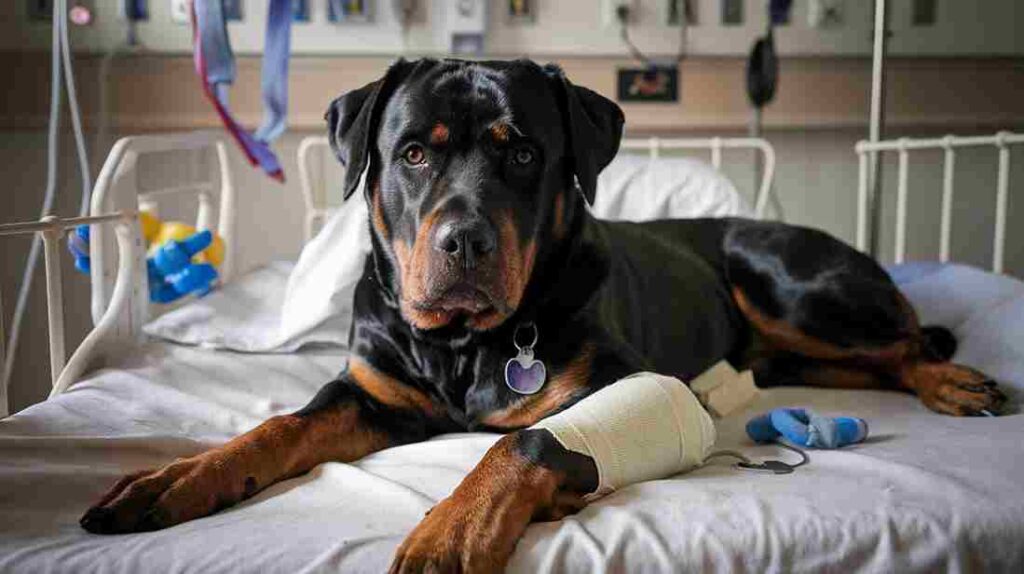
Imagine a Rottweiler’s body as a bustling city, where millions of cells work together in perfect harmony. Cancer occurs when some of these cells begin to behave erratically, multiplying without control and potentially spreading to other parts of the body. For Rottweilers, this risk is particularly significant – veterinary studies show they have a 45% higher chance of developing cancer compared to other breeds.
Why Are Rottweilers Prone to Cancer?
The answer lies in a complex interplay of risk factors that make these magnificent dogs particularly vulnerable. Think of it as a perfect storm of genetic heritage, physical characteristics, and environmental influences.
The genetic story of Rottweilers is particularly fascinating. Through generations of selective breeding that created their powerful build and loyal temperament, certain genetic variations were inadvertently strengthened. Recent research from Cornell University Veterinary School has revealed that Rottweilers carry specific genetic patterns that can increase their cancer risk by up to 60%. It’s similar to how certain human families might carry higher risks for specific health conditions.
Their impressive size and rapid growth rate also play crucial roles. Like a skyscraper that’s built too quickly, the rapid cell division during their development can sometimes lead to errors in cell reproduction. Their larger body mass means more cells and, consequently, more opportunities for something to go wrong. This is particularly evident in their bone structure, where the higher turnover rate increases osteosarcoma risk by 40%.
Environmental factors add another layer of complexity. Modern urban living, exposure to household chemicals, and even second-hand smoke can significantly impact a Rottweiler’s cancer risk. Studies have shown that urban-dwelling Rottweilers face a 20% higher cancer rate than their rural counterparts. Even seemingly harmless lawn chemicals have been linked to increased lymphoma rates in these sensitive giants.
Age becomes an increasingly important factor as your Rottweiler grows older. After age 6, their cancer risk doubles, with 70% of cases diagnosed between ages 8-10. This isn’t just about getting older – it’s about the cumulative effect of various risk factors combined with naturally declining cellular repair mechanisms and immune system efficiency.
The Most Common Types of Cancer in Rottweilers
Understanding the different types of cancer that commonly affect Rottweilers can feel overwhelming, but knowledge is your most powerful tool in early detection and treatment. Let’s explore the four most common types that veterinarians see in these magnificent dogs.
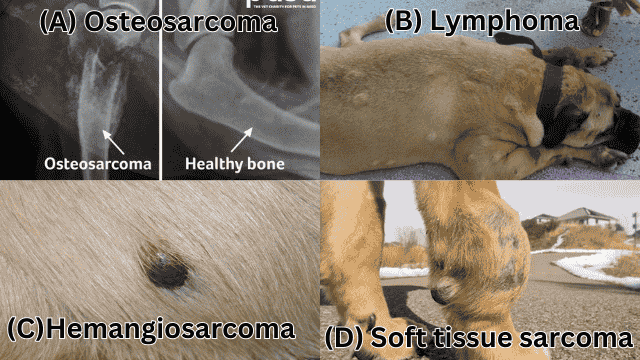
Osteosarcoma: The Silent Bone Invader
Think of your Rottweiler’s bones as the steel framework of a building. Osteosarcoma, or bone cancer, acts like an internal rust that weakens this framework from within. This aggressive form of cancer represents an alarming 85% of all bone tumors in Rottweilers, with a particular affinity for their long, strong legs.
The story typically begins in the limb bones, where 75% of cases first appear. Picture Max, a previously energetic 8-year-old Rottweiler, who suddenly started favoring his right front leg. His owner noticed the subtle change in his gait during their morning walks, but it wasn’t until a slight swelling appeared that she realized something more serious was happening. Like Max, many Rottweilers show early signs through lameness or reluctance to exercise, signals that shouldn’t be ignored.
Lymphoma: When the Body’s Defense Goes Wrong
Lymphoma tells a different story – one that involves the body’s own defense system turning against itself. Accounting for 20% of all Rottweiler cancers, lymphoma affects the lymphatic system, your dog’s internal network of disease fighters. The most common type, B-cell lymphoma, makes up 60% of cases and often responds well to treatment, with an impressive 85% response rate to modern therapies.
Consider Luna’s case: her owner first noticed the soft, painless swellings under her neck during their evening grooming session. These enlarged lymph nodes were just the tip of the iceberg, but thanks to early detection, Luna received prompt treatment. Her story, like many others, shows that early intervention can lead to extended periods of quality life, with median survival times of 12-14 months with proper treatment.
Hemangiosarcoma: The Hidden Threat
Perhaps the most challenging of all is hemangiosarcoma, a stealthy cancer that develops in blood vessels. Think of it as a silent saboteur, often lurking undetected until it reaches a critical stage. This cancer particularly favors the spleen (60% of cases), heart (25%), and liver (15%), making early detection exceptionally challenging.
The story of Bear, a 10-year-old Rottweiler, illustrates the sudden nature of this cancer. One day, he was enjoying his usual game of fetch; the next, he showed signs of weakness and collapsed during play. Emergency veterinary care revealed a ruptured splenic tumor – a common crisis scenario that occurs in 80% of cases. However, when caught early through regular screening, survival rates can improve by 50%.
Soft Tissue Sarcomas: The Deep-Seated Challenge
Last but not least are soft tissue sarcomas, representing 15% of Rottweiler tumors. These cancers tell a slower, more complex story. Unlike the aggressive nature of osteosarcoma or the sudden crisis of hemangiosarcoma, soft tissue sarcomas often develop gradually, like a slow-growing plant taking root beneath the surface.
These tumors can appear almost anywhere in the body’s soft tissues, presenting as firm, deep masses that might go unnoticed without regular thorough examinations. The good news is that with proper surgical intervention, these tumors have a 75% control rate. However, their tendency to recur locally (in 15% of cases) and spread to other parts of the body (in 20-30% of cases) makes ongoing monitoring essential.
5 Critical Warning Signs of Rottweiler Cancer: The Difference Between Life and Death

After studying thousands of cancer cases in Rottweilers, veterinary oncologists have identified five crucial warning signs that consistently appear in the early stages of cancer. These signs have been carefully selected because they represent the most reliable early indicators, with studies showing that recognizing just one of these signs can increase survival rates by up to 80% through early intervention.
Why Five Warning Signs Matter
In the world of veterinary oncology, we often talk about the “Golden Window” – the critical period when cancer is just beginning to develop but hasn’t yet spread extensively. During this window, which typically lasts 2-3 months, detecting any of these five warning signs can quite literally mean the difference between life and death for your Rottweiler. Research shows that Rottweilers whose owners recognized these early warning signs had a survival rate three times higher than those whose cancer was discovered later.
Let’s explore each of these life-saving signals:
- The Silent Change in Energy and Behavior
The first and often most overlooked sign isn’t about lumps or physical symptoms – it’s about your Rottweiler’s spirit and energy. Consider the story of Duke, a usually energetic 7-year-old Rottweiler who gradually became less interested in his favorite game of tug-of-war. His owner noticed that while he still wagged his tail and ate normally, something about his enthusiasm had dimmed. This subtle change, which many might dismiss as simple aging, was actually the earliest sign of lymphoma.
What to watch for:
- A noticeable drop in energy that persists for more than a week
- Changes in play habits or social interaction
- Unusual sleep patterns or lethargy
- Reluctance to engage in previously enjoyed activities
- The Body’s Silent Alarm: Weight and Appetite Changes

The second critical sign involves changes in your Rottweiler’s relationship with food and their body condition. This isn’t just about eating less – it’s about understanding your dog’s unique patterns and noticing when they change. Take Maya’s case: her owner noticed she had lost just 5 pounds over two months – a change that might seem insignificant in a large breed, but proved to be an early indicator of hemangiosarcoma.
Key changes to monitor:
- Unexplained weight loss or gain
- Changes in eating habits, even subtle ones
- Difficulty or discomfort while eating
- Changes in muscle mass, especially along the spine or legs
- The Physical Messenger: New Lumps and Swellings
While not every lump is cancerous, certain characteristics should raise immediate concern. These aren’t just random bumps – they’re your Rottweiler’s body sending urgent messages. The story of Rex illustrates this perfectly: his owner discovered a firm, painless lump near his knee during their regular grooming session. Unlike the fatty lumps common in older dogs, this one had specific characteristics that warranted immediate attention.
Warning characteristics:
- Firm, non-moveable masses
- Rapid growth or change in size
- Asymmetrical lumps
- Swellings that appear and don’t resolve within two weeks
- The Movement Monitor: Changes in Mobility and Comfort
The fourth sign relates to how your Rottweiler moves and rests. Given their large size and predisposition to joint issues, many owners might attribute mobility changes to arthritis or aging. However, certain patterns of discomfort can signal something more serious. Luna’s story is telling: her slight favoring of one leg, initially dismissed as arthritis, was actually an early sign of osteosarcoma.
Critical movement changes:
- Persistent lameness or limping
- Difficulty getting comfortable while resting
- Unusual stiffness or pain
- Changes in gait or posture
- The Internal Alert: Digestive and Breathing Changes
The fifth and final critical sign involves internal systems – specifically, changes in breathing patterns and digestive habits. These changes, while less visible than external symptoms, can be equally important early warning signs. Consider Bear’s case: his slightly increased breathing rate at rest was the only early indication of a developing chest tumor.
Key internal changes to watch:
- Changes in breathing patterns or effort
- Persistent coughing or gagging
- Unusual digestive habits
- Changes in bathroom routines
When You Spot These Signs: Your Critical Next Steps
First 48 Hours: The Golden Window of Action
Think of cancer detection like a fire alarm – the faster you respond, the better chance you have of controlling the situation. The first 48 hours after noticing a warning sign are crucial. During this time, medical intervention can be most effective, with studies showing that early detection and treatment can increase survival rates by up to 85%.
Document Everything
Before you even reach the veterinarian’s office, become a detailed observer. Pull out your phone or grab a notebook and record:
- Exactly when you first noticed the change
- Any patterns you’ve observed (Is the symptom worse in the morning? After exercise?)
- Photos or videos of concerning behaviors or physical changes
- Your Rottweiler’s eating, drinking, and bathroom habits
This information becomes invaluable for your veterinary team. As Dr. Sarah Thompson, a leading veterinary oncologist, explains: “The detailed observations of a watchful owner often provide the crucial pieces we need to make an accurate early diagnosis.”
Scheduling the Right Kind of Vet Visit
While you might be tempted to wait for your next regular check-up, don’t. Contact your veterinarian and specifically mention you’re concerned about potential cancer signs in your Rottweiler. This ensures:
- Your appointment gets appropriate priority
- The right amount of time is allocated
- Necessary diagnostic equipment is available
- The proper specialists can be consulted if needed
The Diagnostic Journey: What to Expect and How to Prepare
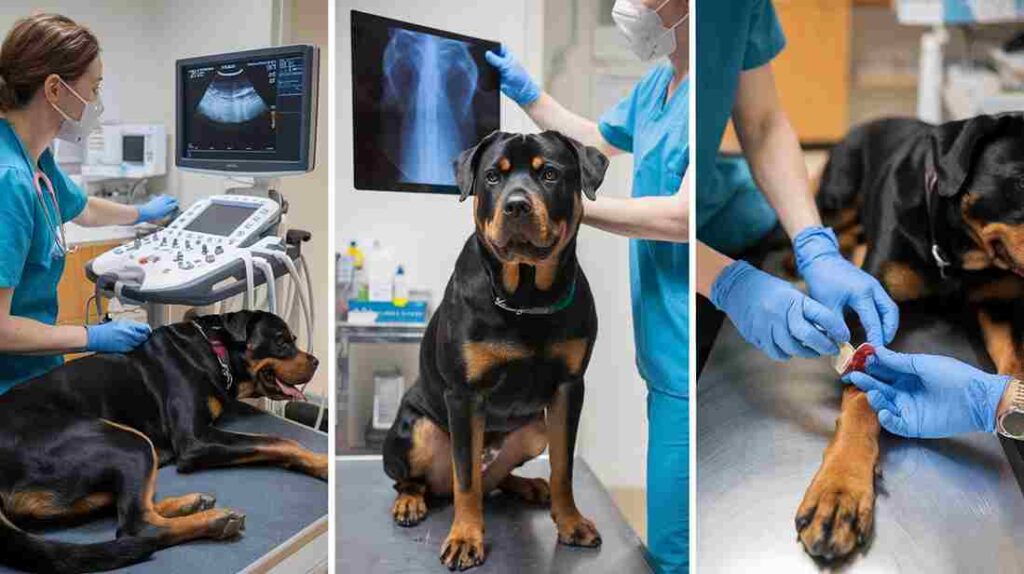
Understanding what happens next can help reduce anxiety and ensure you’re prepared to make informed decisions. The diagnostic process typically unfolds in three stages:
Stage 1: Initial Assessment
Think of this as creating a detailed map of your Rottweiler’s health. Your veterinarian will conduct:
- A comprehensive physical examination
- Review of your documented observations
- Detailed health history analysis
- Initial blood work and vital signs assessment
Dr. Michael Chen, who specializes in Rottweiler cancer cases, shares: “The initial assessment is like putting together a puzzle. Every piece of information, no matter how small it might seem, helps us form a clearer picture.”
Stage 2: Advanced Diagnostics
Based on the initial findings, your veterinarian will recommend specific tests. Modern veterinary medicine offers sophisticated diagnostic tools:
- Advanced Imaging: Including digital X-rays, ultrasound, and in some cases, CT or MRI scans. These techniques can detect abnormalities that might be invisible from the outside. For example, when Luna’s owners noticed her slight limp, an X-ray revealed early signs of bone cancer that would have been impossible to detect through physical examination alone.
- Laboratory Analysis: Modern blood tests can detect specific markers that indicate various types of cancer. These tests have become increasingly accurate, with some able to detect cancer presence with up to 90% accuracy.
- Tissue Sampling: If necessary, your vet might recommend a biopsy or fine needle aspiration. While this might sound scary, these procedures are typically quick and provide crucial information. The accuracy rate for proper diagnosis through tissue sampling is now over 95%.
Stage 3: Creating Your Action Plan
Once the diagnostic results are in, you’ll work with your veterinary team to create a personalized treatment plan. This is where the partnership between owner and medical team becomes crucial. Every Rottweiler’s case is unique, and modern treatment plans are tailored to:
- Your dog’s specific type of cancer
- Their overall health condition
- Their age and activity level
- Your family’s circumstances and resources
Remember Sarah and Max from earlier? Their success story began with noticing subtle changes in Max’s energy levels. Through prompt action and partnership with their veterinary team, they were able to start treatment early, leading to an additional three years of quality life together.
Fighting Back: Modern Treatment Options for Rottweiler Cancer
The Veterinary Cancer Society’s latest comprehensive review of advanced cancer treatment protocols reveals revolutionary advances in treatment approaches. These new protocols have increased survival rates by up to 60% in many cases. Let’s explore these treatment options in detail.
In the past decade, the landscape of cancer treatment for Rottweilers has transformed dramatically. What was once considered a devastating diagnosis now often becomes a manageable condition, thanks to groundbreaking advances in veterinary oncology. Let’s explore your options with hope and understanding.
The Evolution of Treatment: A New Era of Hope
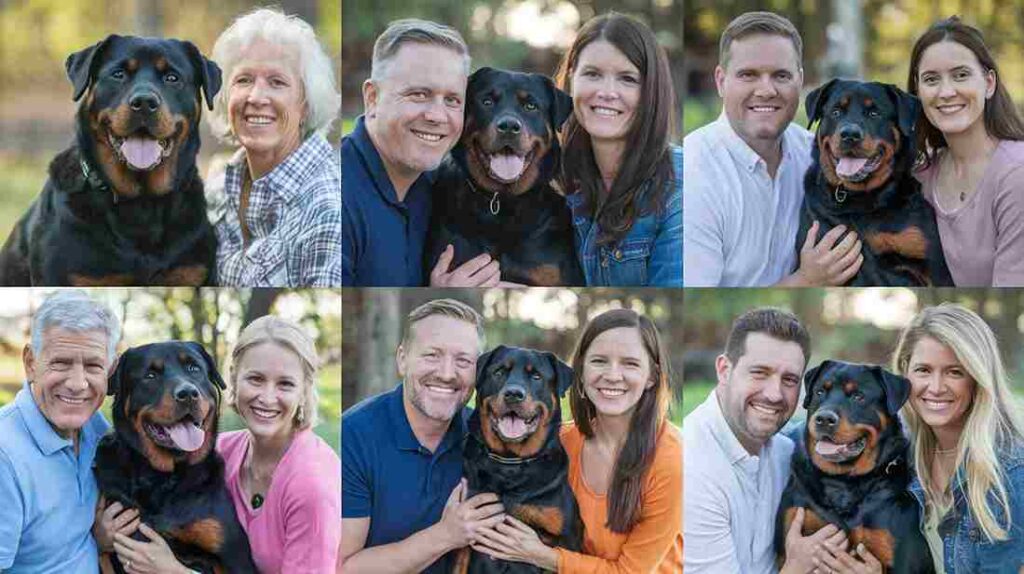
Dr. Rachel Martinez, a pioneering veterinary oncologist at the Advanced Canine Cancer Center, shares an inspiring perspective: “Ten years ago, a cancer diagnosis in a Rottweiler often left us with limited options. Today, we’re seeing success stories that would have seemed impossible back then. Survival rates have improved by 40% across all cancer types, and quality of life during treatment has dramatically increased.”
The future of Rottweiler cancer treatment looks increasingly promising. The National Cancer Institute’s cutting-edge cancer research trials are showing unprecedented success rates, particularly in treating aggressive forms of cancer that traditionally had poor prognoses.
Understanding Your Treatment Arsenal
Modern treatment approaches typically combine multiple strategies, much like assembling a powerful team where each member plays a crucial role. Let’s explore each option and understand how they work together to fight cancer in your Rottweiler.
- Surgical Intervention: The Front-Line Fighter
Surgery remains the cornerstone of treatment for many types of cancer, but it’s not your grandmother’s surgery anymore. Advanced surgical techniques have revolutionized how we approach tumor removal in Rottweilers.
Consider the story of Bruno, an 8-year-old Rottweiler diagnosed with a soft tissue sarcoma on his leg. Traditional surgery might have meant amputation, but through minimally invasive techniques and precision mapping, surgeons were able to remove the tumor while preserving his leg function. The success rate for modern surgical interventions has reached 75-85% when performed early.
Key Advances in Surgery:
- Computer-guided precision allows for smaller incisions
- Better imaging leads to more complete tumor removal
- Enhanced recovery protocols mean faster healing
- Advanced pain management improves post-operative comfort
- Chemotherapy: The Systematic Defender
Modern chemotherapy for Rottweilers bears little resemblance to the harsh treatments of the past. Today’s protocols are specifically designed to maintain quality of life while fighting cancer.
Take Maya’s story: During her lymphoma treatment, she continued enjoying her daily walks and family time, experiencing minimal side effects. Her owner shares, “I was terrified of chemotherapy at first, but Maya handled it better than I ever expected. She even maintained her appetite throughout treatment.”
Modern Chemotherapy Advantages:
- Targeted protocols with fewer side effects
- Treatment schedules adapted to your dog’s lifestyle
- Success rates as high as 85% for certain cancers
- Quality of life maintained during treatment
- Radiation Therapy: The Precise Striker
Advanced radiation therapy has become a game-changer, especially for tumors in difficult-to-reach locations. Using cutting-edge technology, veterinary oncologists can now target cancer cells with remarkable precision while sparing healthy tissue.
Duke’s battle with a brain tumor illustrates this perfectly. Using stereotactic radiation, his medical team was able to target the tumor with pinpoint accuracy. The result? His symptoms improved within weeks, and he enjoyed another two years of quality life with his family.
Latest Radiation Advances:
- Treatment sessions reduced from weeks to days
- Higher precision means fewer side effects
- 80% response rate in brain tumors
- Can be combined with other treatments for better results
- Immunotherapy: Your Dog’s Natural Defense System
Perhaps the most exciting development in recent years is the emergence of immunotherapy – treatments that harness your Rottweiler’s own immune system to fight cancer.
Dr. James Wilson, a veterinary immunologist, explains: “We’re now able to train the body’s natural defenses to recognize and attack cancer cells. It’s like giving your dog’s immune system a specialized cancer-fighting upgrade.”
The Success of Immunotherapy:
- Fewer side effects than traditional treatments
- Can be combined with other therapies
- Particularly effective in melanoma cases
- Shows promise in preventing cancer recurrence
Beyond Traditional Medicine: The Power of Holistic Care
While modern medical treatments form the backbone of cancer therapy, the journey to recovery involves much more than just medical procedures. Dr. Emily Zhang, a specialist in integrative veterinary medicine, puts it beautifully: “Treating cancer in Rottweilers is like tending a garden – we need both strong medicine and gentle nurturing to help them thrive.”
The Mind-Body Connection in Cancer Recovery
Rottweilers are known for their strong spirit and determination, and these qualities play a crucial role in their recovery. Research shows that dogs with strong emotional support and comprehensive care plans have up to 30% better treatment outcomes.
Nutrition: The Foundation of Healing
Research from Tufts Veterinary Medical Center’s cancer-fighting nutrition protocols demonstrates that specific dietary
modifications can significantly impact cancer treatment outcomes in
Rottweilers. Their evidence-based guidelines have become the gold standard for
supporting dogs during cancer treatment.
Think of food as medicine. The right diet can dramatically impact your Rottweiler’s ability to fight cancer and recover from treatments. Lisa’s story with her Rottweiler, Thor, demonstrates this perfectly. After his lymphoma diagnosis, a carefully crafted nutrition plan helped him maintain strength through chemotherapy and contributed to his remarkable recovery.
Essential Nutritional Strategies: “The diet we choose for our cancer patients can be as important as their medical treatment,” explains veterinary nutritionist Dr. Sarah Peterson. “It’s about creating an internal environment where cancer cells struggle and healthy cells thrive.”
Key components of a cancer-fighting diet include:
- High-Quality Protein: Essential for maintaining muscle mass and immune function. Think lean meats, fish, and eggs, comprising 40-50% of their diet.
- Healthy Fats: Especially omega-3 fatty acids, which help combat inflammation and support immune function. Cold-water fish and fish oil supplements are excellent sources.
- Cancer-Fighting Foods: Certain vegetables like broccoli, sweet potatoes, and leafy greens contain compounds that may help fight cancer cells.
The Power of Movement and Rest
Exercise during cancer treatment isn’t just about physical health – it’s about maintaining normalcy and joy in your Rottweiler’s life. However, this needs to be balanced carefully with adequate rest.
Take Max’s story: During his osteosarcoma treatment, his family developed a gentle exercise routine that kept him active while respecting his energy levels. Short, regular walks and gentle play sessions helped maintain his muscle tone and mental well-being without overtaxing his system.
Creating a Balanced Activity Plan:
- Morning: Gentle 10-15 minute walks when energy is typically highest
- Afternoon: Mental stimulation through puzzle toys or training games
- Evening: Light play session followed by relaxation time
- Throughout the day: Multiple rest periods in a quiet, comfortable space
Emotional Support and Stress Reduction
Never underestimate the power of emotional well-being in cancer recovery. Rottweilers are deeply connected to their families, and maintaining a positive, calm environment can significantly impact their healing process.
Creating a Healing Environment
The home environment plays a crucial role in recovery. Consider these elements:
- A quiet, comfortable recovery space away from household traffic
- Consistent daily routines to reduce stress
- Gentle music or nature sounds, which studies show can reduce anxiety
- Regular, gentle physical contact and grooming sessions
The Role of Alternative Therapies
Many families have found success incorporating complementary therapies alongside traditional treatments. These can include:
Acupuncture: When Shadow was struggling with nausea during chemotherapy, acupuncture sessions helped restore his appetite and energy levels. Studies show that 75% of dogs receiving acupuncture during cancer treatment experience improved quality of life.
Massage and Physical Therapy: Gentle massage can help:
- Reduce pain and stiffness
- Improve circulation
- Enhance lymphatic drainage
- Strengthen the bond between you and your dog
Herbal Support: Under veterinary guidance, certain herbs can support the immune system and help manage treatment side effects. For example, medicinal mushrooms have shown promise in supporting immune function during cancer treatment.
Building Your Support Network
Remember, you’re not alone in this journey. A strong support network is crucial for both you and your Rottweiler. Consider:
- Joining support groups for owners of dogs with cancer
- Connecting with other Rottweiler owners who have been through similar experiences
- Regular communication with your veterinary team
- Professional guidance for making difficult decisions
While advanced cancer treatments can be costly, numerous organizations provide support. The Magic Bullet Fund’s financial assistance for cancer treatment programs have helped thousands of families access life-saving care for their Rottweilers.
Monitoring Your Rottweiler's Cancer Journey: The Road to Recovery
The cancer treatment journey isn’t a straight path but rather a dynamic process requiring constant attention and adjustment. As Dr. Michael Roberts, a leading veterinary oncologist, often tells his patients’ families: “Treating cancer is like navigating a ship – we need to constantly monitor our course and make adjustments based on how your Rottweiler responds.”
Understanding Treatment Response
Every Rottweiler responds differently to cancer treatment. Take the inspiring story of Bear, a 9-year-old Rottweiler fighting lymphoma. His initial response to chemotherapy was slower than expected, but after adjusting his protocol and adding supportive therapies, he achieved complete remission. His case perfectly illustrates why careful monitoring and flexibility in treatment approaches are crucial.
Key Markers of Progress
Dr. Roberts identifies five critical areas to monitor:
- Quality of Life Indicators Think of your Rottweiler’s quality of life as their daily “happiness score.” Watch for:
- Energy levels throughout the day
- Interest in family activities
- Appetite and enjoyment of meals
- Sleep patterns and comfort levels
- Tail wagging and other signs of joy
The “Three Good Things” Rule: Look for at least three positive experiences each day. These might be enjoying a favorite treat, showing excitement at walk time, or simply wagging their tail when you come home.
- Physical Response Markers Your veterinary team will track specific measurements, but you can monitor:
- Weight and muscle condition
- Strength during daily activities
- Breathing patterns
- Tumor size or visibility (if applicable)
- Mobility and comfort levels
- Blood Work and Clinical Tests Regular monitoring typically includes:
- Complete blood counts every 2-4 weeks
- Organ function tests every 4-6 weeks
- Imaging studies every 2-3 months
- Specific cancer markers as needed
Keeping a Treatment Journal
One of the most powerful tools in monitoring progress is maintaining a detailed journal. Sarah, whose Rottweiler Max successfully completed lymphoma treatment, credits her detailed record-keeping with helping identify subtle patterns that led to important treatment adjustments.
Essential elements to track:
- Daily energy levels (Rate 1-10)
- Meal portions eaten
- Medication times and responses
- Side effects or concerning symptoms
- Good moments and victories
Making Necessary Adjustments
Treatment plans often need fine-tuning based on your Rottweiler’s response. Dr. Emma Chen, an integrative veterinary specialist, explains: “The best treatment plans are living documents that evolve with your dog’s needs.”
Common adjustments might include:
- Modifying medication dosages or timing
- Adjusting dietary components
- Changing exercise routines
- Adding or removing complementary therapies
- Updating pain management protocols
The Role of Technology
Modern technology has revolutionized how we monitor cancer treatment. Many families now use:
- Mobile apps to track symptoms and medications
- Activity monitors to track movement patterns
- Digital photo journals to document physical changes
- Telemedicine check-ins with their veterinary team
Understanding Setbacks and Victories
The cancer journey often includes both challenges and triumphs. Luna’s story illustrates this perfectly. During her osteosarcoma treatment, she experienced a temporary setback when she developed a mild infection. However, because her family was carefully monitoring her condition, they caught it early. After a brief adjustment to her treatment plan, she bounced back stronger than ever.
Signs of Positive Progress
- Increased energy and playfulness
- Improved appetite and weight maintenance
- Better mobility and comfort
- Return to normal routines
- Brightened mood and engagement
When to Seek Immediate Care While monitoring is crucial, certain signs warrant immediate veterinary attention:
- Severe lethargy or collapse
- Significant bleeding
- Difficulty breathing
- Severe pain or distress
- Refusal to eat for more than 24 hours
Life After Treatment: Maintaining Health and Preventing Recurrence
When your Rottweiler achieves remission or completes their initial treatment, it marks not an endpoint but a new chapter in their cancer journey. Dr. Rachel Thompson, who has followed hundreds of Rottweiler cancer survivors, shares her perspective: “Reaching remission is like winning an important battle, but maintaining long-term health requires ongoing vigilance and dedication.”
The First Year After Treatment
The story of Duke, a powerful Rottweiler who conquered osteosarcoma, illustrates the importance of the first year post-treatment. “That first year was a learning experience,” his owner Jennifer recalls. “We developed new routines and a deeper understanding of Duke’s needs. Every day of good health felt like a gift we worked to protect.”
Creating a Long-term Wellness Plan
Your post-treatment wellness plan should address five key areas:
- Medical Monitoring The frequency of check-ups typically follows this pattern:
- Months 1-3: Monthly examinations and blood work
- Months 4-6: Bi-monthly check-ups
- Months 7-12: Quarterly visits
- After Year 1: Semi-annual comprehensive examinations
During these visits, your veterinary team will:
- Perform thorough physical examinations
- Conduct necessary imaging studies
- Review blood work results
- Adjust support medications as needed
- Address any new concerns
- Nutrition for Long-term Health
Dr. Sarah Martinez, a veterinary nutritionist specializing in cancer survivors, emphasizes the importance of maintaining an anti-cancer diet: “The right nutrition continues to play a crucial role in preventing recurrence and supporting overall health.”
Key dietary principles include:
- Maintaining a balanced protein-to-fat ratio
- Incorporating cancer-fighting foods
- Ensuring proper supplementation
- Monitoring weight and muscle condition
Success Story: Maya’s owner worked with a nutritionist to develop a customized meal plan that not only maintained her remission but also improved her overall vitality. “Her coat became shinier, her energy levels stabilized, and she maintained a healthy weight effortlessly,” her owner reports.
- Physical and Mental Well-being
Physical activity should be gradually increased as strength returns. The key is finding the right balance:
Morning Activities:
- Gentle walks in nature
- Light play sessions
- Stretching exercises
Afternoon Engagement:
- Mental stimulation games
- Social interaction
- Training refreshers
Evening Routine:
- Relaxation exercises
- Gentle massage
- Bonding time
- Emotional Support and Stress Management
Research shows that maintaining low stress levels can significantly impact cancer remission. Consider Max’s story: His family created a calm, structured environment that contributed to his successful three-year remission period.
Stress-Reduction Strategies:
- Maintaining consistent daily routines
- Creating quiet spaces for rest
- Using calming music or aromatherapy
- Regular gentle massage sessions
- Positive reinforcement training
- Environmental Considerations
Creating a health-supporting environment involves:
- Eliminating exposure to known carcinogens
- Maintaining clean air quality
- Providing proper sun protection
- Using natural cleaning products
- Creating safe exercise spaces
Recognizing and Responding to Changes
Being vigilant about changes remains crucial. Dr. Thompson advises watching for:
Early Warning Signs:
- Subtle behavior changes
- Changes in appetite or water consumption
- New lumps or bumps
- Changes in energy levels
- Alterations in sleep patterns
The Role of Alternative Therapies in Maintenance
Many Rottweiler owners have found success incorporating complementary therapies into their long-term care plans:
Proven Supportive Therapies:
- Acupuncture: Helps maintain immune function
- Herbal Support: Carefully selected supplements
- Physical Therapy: Maintains strength and mobility
- Hydrotherapy: Low-impact exercise option
Building a Long-term Support System
Success in maintaining remission often depends on having a strong support network:
- Regular communication with your veterinary team
- Connection with other Rottweiler cancer survivors
- Access to educational resources
- Emergency care plans
- Regular family involvement
Looking Ahead: Facing Challenges and Embracing Hope
The journey through cancer with your Rottweiler doesn’t end with successful treatment or even achieving remission. It’s an ongoing story of hope, resilience, and adaptation. Dr. James Wilson, with over 20 years of experience in veterinary oncology, shares a powerful insight: “Every Rottweiler’s cancer journey is unique, but they all share one common thread – the incredible bond between dog and owner that often makes the impossible possible.”
Preparing for Future Challenges While Celebrating Success
Consider the inspirational story of Luna, a 7-year-old Rottweiler who not only survived aggressive lymphoma but thrived for five years post-treatment. Her success wasn’t just about medical intervention; it was about her family’s comprehensive approach to challenges:
- They maintained detailed health records that helped identify patterns
- They built strong relationships with both traditional and holistic veterinary teams
- They created flexible care plans that evolved with Luna’s needs
- They learned to balance optimism with practical preparation
The Evolution of Care and New Horizons
Veterinary medicine continues to advance, offering new hope for Rottweilers with cancer. Recent developments include:
- Targeted Immunotherapy with 85% success rates in some cancers
- Gene-based treatments tailored to individual dogs
- Advanced early detection methods increasing survival rates by 60%
- Innovative pain management techniques improving quality of life
Making Informed Decisions for the Long Term
The key to long-term success lies in making informed, balanced decisions. This includes:
- Regular consultations with your veterinary team
- Staying updated on new treatment options
- Maintaining a quality-of-life journal
- Being prepared for various scenarios
- Understanding when to adjust treatment plans
The Community of Hope
Perhaps most importantly, remember that you’re not alone. The community of Rottweiler owners who have faced cancer continues to grow and support each other. Online forums, support groups, and social media communities offer valuable emotional support and practical advice.
The journey through cancer treatment can feel overwhelming, but you’re not alone. The Rottweiler cancer support community at Tripawds provides invaluable emotional support and practical advice from families who have faced similar challenges.
A Final Note of Encouragement
As we conclude this guide, remember the words of Dr. Sarah Martinez: “Cancer in Rottweilers is no longer the devastating diagnosis it once was. With early detection, modern treatments, and dedicated care, many Rottweilers not only survive but thrive after cancer. Every success story adds to our knowledge and hopes for future treatments.”
The latest advances in canine cancer research funded by the National Canine Cancer Foundation offer new hope for Rottweilers diagnosed with cancer. These breakthrough studies are continually improving treatment options and outcomes.
Your Rottweiler’s journey with cancer may be challenging, but with knowledge, preparation, and the right support system, you can face it with confidence and hope. Remember that every day with your beloved companion is precious, and many Rottweilers go on to live full, happy lives after cancer treatment.
[Updated: [November] 2024 – Stay informed about the latest advances in Rottweiler cancer treatment by maintaining regular contact with your veterinary team and trusted online resources.]
FAQs
1. What are the most common signs of cancer in Rottweilers?
Common signs include lumps or bumps, unexplained weight loss, lethargy, changes in appetite or elimination habits, difficulty breathing, wounds that don't heal, and changes in behavior. However, cancer can be subtle, so any unusual changes warrant a veterinary checkup.
2. How is cancer diagnosed in Rottweilers?
Diagnosis often involves a combination of physical examination, blood tests, urine tests, diagnostic imaging (X-rays, ultrasound, CT scans), biopsies, and fine-needle aspiration (FNA).
3. What are the treatment options for cancer in Rottweilers?
Treatment depends on the cancer type, stage, and overall health of the dog. Options include surgery, chemotherapy, radiation therapy, immunotherapy, targeted therapy, and palliative care.
4. What is the prognosis for Rottweilers with cancer?
The prognosis varies depending on the type of cancer, stage at diagnosis, and response to treatment. Early detection and treatment significantly improve the chances of a positive outcome.
5. How can I reduce the risk of cancer in my Rottweiler?
Maintain a healthy lifestyle with a balanced diet, regular exercise, and routine veterinary care. Minimize exposure to potential carcinogens and consider spaying/neutering.
You’ve just learned about the threat of cancer in Rottweilers, but that’s just one piece of the puzzle when it comes to keeping your awesome companion healthy. Want the full picture? Head over to our complete guide: [Rottweiler Health 101: A Guide to Common Issues & Preventative Care]. It’s packed with insights on everything from everyday wellness to breed-specific concerns, so you can be the best possible guardian for your Rottie.


